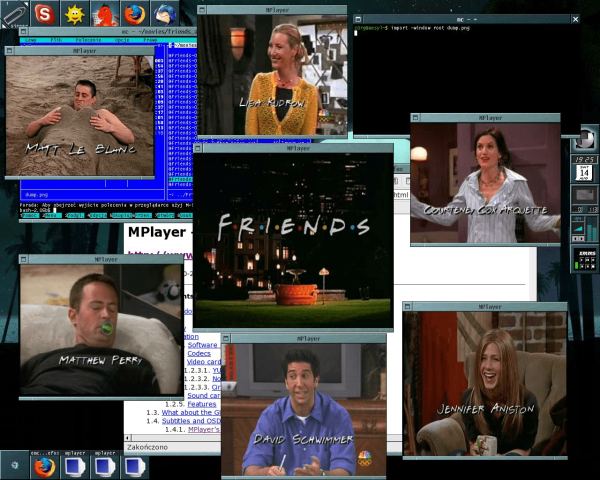MPlayer is a very popular movie player which runs on many systems including Linux. It has builtin support for the most common video and audio formats (see list below), as well as having a powerful filter system for video and audio manipulation.
MPlayer currently works best from the command line, but visual feedback for many functions is available from its onscreen status display (OSD), which is also used for displaying subtitles. MPlayer also has a Graphical User Interface (GUI) with skin support and several unofficial alternative graphical frontends are available.
MPlayer supports displaying through some hardware MPEG decoder boards, such as the DVB and DXR3/Hollywood+.
MPlayer has an onscreen display (OSD) for status information, nice big antialiased shaded subtitles and visual feedback for keyboard controls. European/ISO 8859-1,2 (Hungarian, English, Czech, etc), Cyrillic and Korean fonts are supported along with 12 subtitle formats (MicroDVD, SubRip, OGM, SubViewer, Sami, VPlayer, RT, SSA, AQTitle, JACOsub, PJS and our own: MPsub). DVD subtitles (SPU streams, VOBsub and Closed Captions) are supported as well.
The player is rock solid playing damaged MPEG files (useful for some VCDs), and it plays bad AVI files which are unplayable with the famous windows media player.
Features include:
- Supported Input Formats: (S)VCD (Super Video CD), CDRwin’s .bin image file, DVD, including encrypted DVD, MPEG-1/2 (ES/PS/PES/VOB), RIFF AVI file format, ASF/WMV/WMA format, QT/MOV/MP4 format, RealAudio/RealVideo format, Ogg/OGM files, Matroska, NUT, NSV
(Nullsoft Streaming Video), VIVO format, FLI format, NuppelVideo format, yuv4mpeg format, FILM (.cpk) format, RoQ format, PVA format, streaming via HTTP/FTP, RTP/RTSP, MMS/MMST, MPST, SDP, and TV grabbing. - Supported Video and Audio Codecs: MPEG-1 (VCD) and MPEG-2 (SVCD/DVD/DVB) video, MPEG-4 in all variants including DivX ;-), OpenDivX (DivX4), DivX 5 (Pro), XviD, Windows Media Video 7/8 (WMV1/2), Windows Media Video 9 (WMV3) (using x86 DLL), RealVideo 1.0, 2.0 (G2),
RealVideo 3.0 (RP8), 4.0 (RP9) (using Real libraries), Sorenson v1/v3 (SVQ1/SVQ3), Cinepak, RPZA and other QuickTime codecs, DV video, 3ivx, Intel Indeo3 (3.1, 3.2), Intel Indeo 4.1 and 5.0 (using x86 DLL or XAnim codecs), VIVO 1.0, 2.0, I263 and other H.263(+) variants (using
x86 DLL), MJPEG, AVID, VCR2, ASV2 and other hardware formats, FLI/FLC, HuffYUV, and various old simple RLE-like formats. - Supported audio codecs: MPEG layer 1, 2, and 3 (MP3) audio, AC3/A52 (Dolby Digital) audio (software or SP/DIF), AAC (MPEG-4 audio), WMA (DivX Audio) v1, v2, WMA 9 (WMAv3), Voxware audio, ACELP.net etc (using x86 DLLs), RealAudio: COOK, SIPRO, ATRAC3 (using Real libraries), RealAudio: DNET and older codecs, QuickTime: Qclp, Q-Design QDMC/QDM2, MACE 3/6 (using QT libraries), ALAC, Ogg Vorbis audio, VIVO audio (g723, Vivo Siren) (using x86 DLL), alaw/ulaw, (ms)gsm, pcm, *adpcm and other simple old audio formats.
- Supported Video Output Devices: X11 with SHM extension, X11 using overlays with the Xvideo extension (hardware YUV & scaling), Xvideo Motion Compensation, VIDeo Interface for *niX, VIDIX in an X11 window, VIDIX on the console, X11 DGA extension (both v1.0 and v2.0), OpenGL renderer, gl2, framebuffer output, SVGAlib output (supports EGA displays), SDL >= v1.1.7 driver, GGI graphics output, text mode rendering, text mode rendering in color, display through the VESA BIOS (also needed for Radeon TV-out), and DirectFB support.
- Supported Audio Output Devices: OSS (Open Sound System), SDL (Simple Directmedia Layer), ALSA (Advanced Linux Sound Architecture), NAS (Network Audio System), ESD (ESound Daemon), ARTS (KDE Sound System),and JACK (Jack Audio Connection Kit).
- Streaming: Authentication for Real RTSP stream.
Website: www.mplayerhq.hu
Support: Documentation, Mailing Lists
Developer: Large number of contributors
License: GNU General Public License v2.0

MPlayer is written in C. Learn C with our recommended free books and free tutorials.
Return to Video | Return to Media Players | Return to DVD Tools | Return to Console Multimedia
| Popular series | |
|---|---|
| The largest compilation of the best free and open source software in the universe. Each article is supplied with a legendary ratings chart helping you to make informed decisions. | |
| Hundreds of in-depth reviews offering our unbiased and expert opinion on software. We offer helpful and impartial information. | |
| The Big List of Active Linux Distros is a large compilation of actively developed Linux distributions. | |
| Replace proprietary software with open source alternatives: Google, Microsoft, Apple, Adobe, IBM, Autodesk, Oracle, Atlassian, Corel, Cisco, Intuit, SAS, Progress, Salesforce, and Citrix | |
| Awesome Free Linux Games Tools showcases a series of tools that making gaming on Linux a more pleasurable experience. This is a new series. | |
| Machine Learning explores practical applications of machine learning and deep learning from a Linux perspective. We've written reviews of more than 40 self-hosted apps. All are free and open source. | |
| New to Linux? Read our Linux for Starters series. We start right at the basics and teach you everything you need to know to get started with Linux. | |
| Alternatives to popular CLI tools showcases essential tools that are modern replacements for core Linux utilities. | |
| Essential Linux system tools focuses on small, indispensable utilities, useful for system administrators as well as regular users. | |
| Linux utilities to maximise your productivity. Small, indispensable tools, useful for anyone running a Linux machine. | |
| Surveys popular streaming services from a Linux perspective: Amazon Music Unlimited, Myuzi, Spotify, Deezer, Tidal. | |
| Saving Money with Linux looks at how you can reduce your energy bills running Linux. | |
| Home computers became commonplace in the 1980s. Emulate home computers including the Commodore 64, Amiga, Atari ST, ZX81, Amstrad CPC, and ZX Spectrum. | |
| Now and Then examines how promising open source software fared over the years. It can be a bumpy ride. | |
| Linux at Home looks at a range of home activities where Linux can play its part, making the most of our time at home, keeping active and engaged. | |
| Linux Candy reveals the lighter side of Linux. Have some fun and escape from the daily drudgery. | |
| Getting Started with Docker helps you master Docker, a set of platform as a service products that delivers software in packages called containers. | |
| Best Free Android Apps. We showcase free Android apps that are definitely worth downloading. There's a strict eligibility criteria for inclusion in this series. | |
| These best free books accelerate your learning of every programming language. Learn a new language today! | |
| These free tutorials offer the perfect tonic to our free programming books series. | |
| Linux Around The World showcases usergroups that are relevant to Linux enthusiasts. Great ways to meet up with fellow enthusiasts. | |
| Stars and Stripes is an occasional series looking at the impact of Linux in the USA. | |
